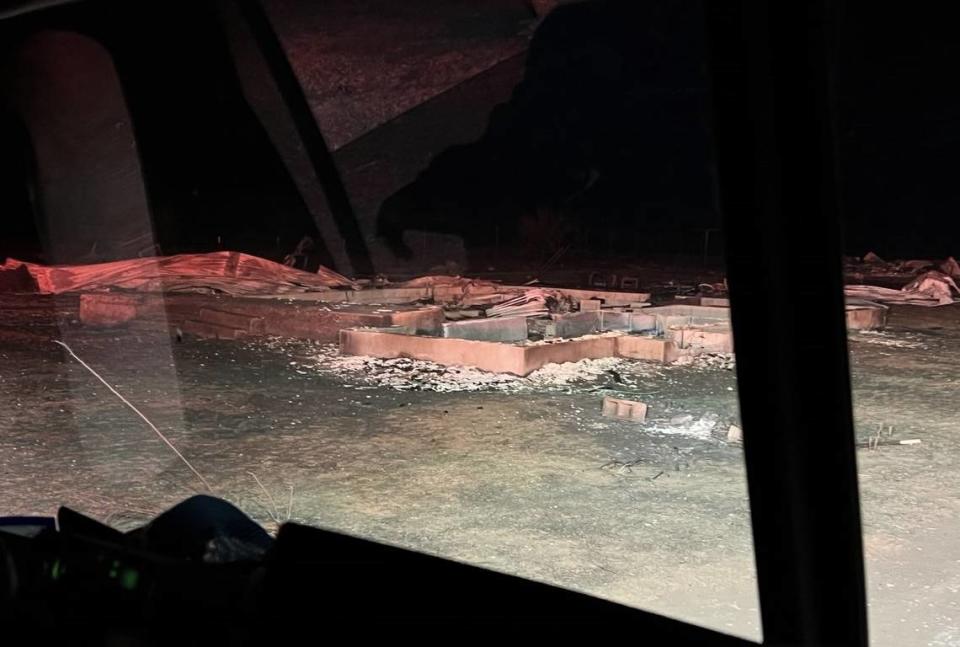Who could be liable for up to 500 structures destroyed in Texas Panhandle wildfire?
- Oops!Something went wrong.Please try again later.
In our Reality Check stories, Star-Telegram journalists dig deeper into questions over facts, consequences and accountability. Send story ideas to RealityCheck@star-telegram.com.
A preliminary assessment shows the deadly Smokehouse Creek Fire in Texas has destroyed as many as 500 structures since it ignited on Feb. 26, and a woman who lost her home is suing a Panhandle electric utility for the devastation.
“When you look at the damages that have occurred here, it’s just gone, completely gone,” said Gov. Greg Abbott during a press conference Friday. “Nothing left but ashes on the ground.”
Abbott visited the community of Borger in Hutchinson County on Friday. He said the damage assessment is ongoing, and there’s no way to say with certainty that 400-500 structures is the final count.
The Smokehouse Creek Fire, now the largest recorded wildfire in Texas history, has killed two people so far. By Sunday it had burned nearly 1.1 million acres and was only 15% contained, the Texas A&M Forest Service said on X.
Update: the #SmokehouseCreekFire in Hutchinson County is an estimated 1,076,638 acres and 15% contained. Firefighters continue suppression actions on the fire. Aviation provided support on the fire. Acreage change due to more accurate mapping. This is subject to change. #txfire pic.twitter.com/e2GGxktFfE
— Incident Information - Texas A&M Forest Service (@AllHazardsTFS) March 3, 2024
The cause of the massive blaze is under investigation, but a Panhandle homeowner has filed a lawsuit against Xcel Energy in Hemphill County, Reuters reported. The suit alleges that a power pole, owned by Xcel subsidiary Southwestern Public Service Company, fell and ignited the fire.
Osmose Utilities Service, a utilities maintenance and inspection company, was also named as a defendant in the lawsuit.
Today's top stories:
→ ‘More people equals more violence.’ Locals reflect on W 7th shooting
→ Friends remember man killed in West 7th district as kind, smart, caring
→ Get ready for ‘the bloodletting.’ School districts in for rocky budget season.
🚨Get free alerts when news breaks.
Xcel Energy filed a report with the Securities and Exchange Commission on Wednesday, stating that the company had received a letter from a legal firm working “on behalf of various property insurance interests whose insureds were allegedly adversely affected by the Smokehouse Creek Fire.”
The letter gave Xcel “notice of potential exposure for damages” caused by the fire and requested that a fallen Southwestern Public Service utility pole located near the fire’s potential origin “be preserved,” according to the report.
Xcel said in a statement that it would “cooperate with officials while conducting our own investigations to determine the causes of the fires,” the Texas Tribune reported.

Poor utility maintenance can have deadly results
On Friday, the Star-Telegram spoke with a wildfire recovery attorney who shared insights into who could be held accountable for the fire and how victims could prepare if they want to file a claim for damages.
Gerry Singleton, a managing partner at Singleton Schreiber, encouraged residents to thoroughly document the damage to their property.
“If you lost something and you buy something to replace it, you want to save that receipt,” Singleton said. “You want to take pictures of the damage, and those are really the most important things that you can do.”
Singleton, whose law firm has handled cases related to wildfires in California, Colorado and Maui, said Xcel could potentially have to pay several hundred million dollars in damages if an investigation reveals the utility company’s equipment ignited the fire.
“What happens is — particularly in more rural areas, in more remote areas — a lot of times these older wooden poles aren’t replaced when they should be,” Singleton said. “And so because of that, because of the wear and tear and the damage from termites, from woodpeckers, from you know, wood rot, all of these various things, they could become structurally unsound.”
According to Singleton, investigators will explore all potential causes, including natural causes like lightning, though it seems unlikely that lightning was a factor in the Smokehouse Creek Fire.
In cases where an electric company was ultimately found responsible and held liable for igniting a wildfire, Singleton said it was because they didn’t conduct proper inspections.
“They make incredible amounts of money, and they deliberately fail to take the precautions that they should,” he said. “They know they’re dealing with high-voltage electricity, which is incredibly dangerous and incredibly disruptive. And yet, they still try to skimp on the maintenance and inspection because it’s a good way to increase their bottom line.”
This type of skimping on maintenance is “a moral hazard” with potentially deadly results, according to Singleton. In situations like this, litigation is both a way to recover money for wildfire victims and a means of pressuring companies to change dangerous business practices, he said.
“If we do our job right, we’re making it expensive, or more expensive, for these companies to operate in a dangerous way than to operate in a safe way,” Singleton said. “And if we can do that, then we’ve performed an important function.”

